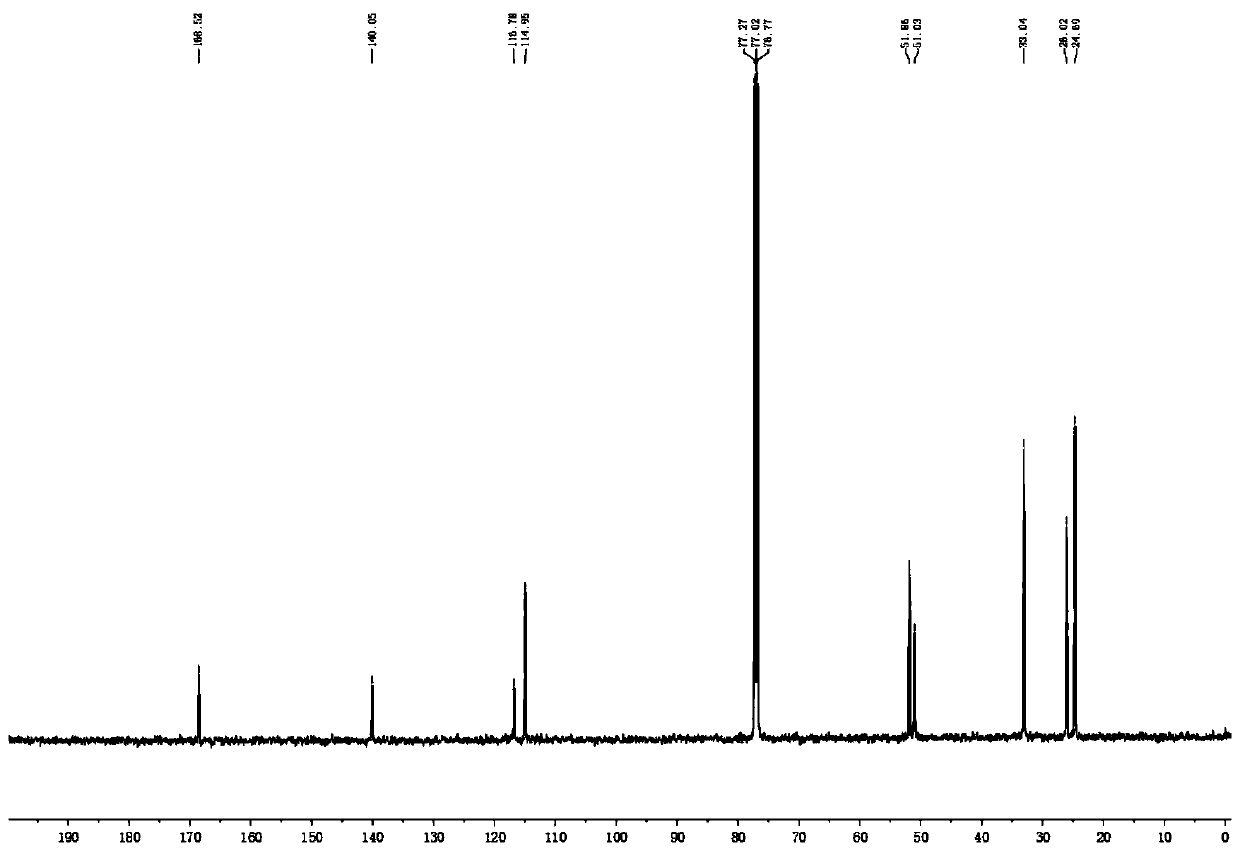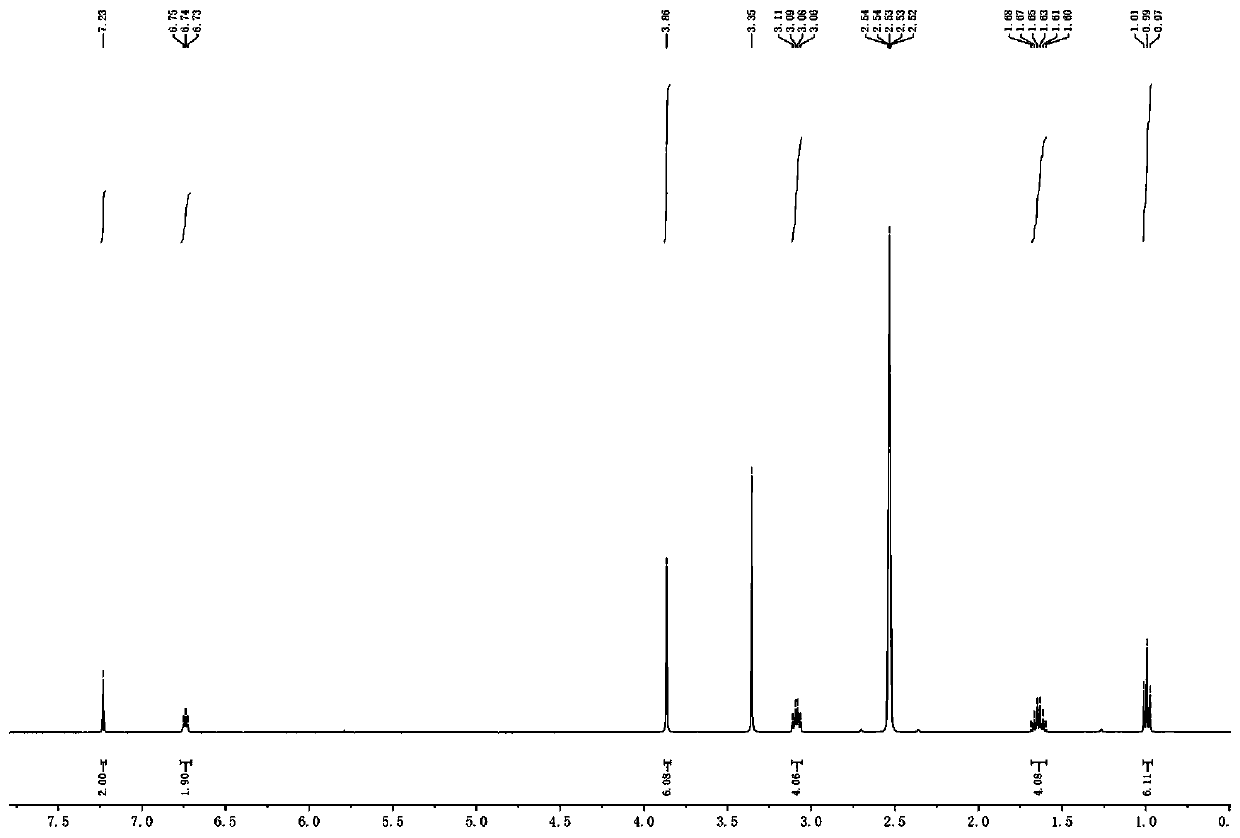Cell lipid droplet fluorescence imaging probe based on single benzene ring skeleton and application thereof
A fluorescence imaging and cell lipid technology, which is applied in the direction of fluorescence/phosphorescence, material analysis by optical means, material excitation analysis, etc., can solve the problems of crossover, low signal-to-noise ratio, low dyeing selectivity, etc., to avoid crossover, Good photostability and high dyeing selectivity
- Summary
- Abstract
- Description
- Claims
- Application Information
AI Technical Summary
Problems solved by technology
Method used
Image
Examples
Embodiment 1
[0033] Synthesis of Dimethyl 2,5-Bis(cyclohexylamino)terephthalate (Ph-Red)
[0034] Add dimethyl 1,4-cyclohexanedione-2,5-dicarboxylate (228mg, 1.00mmol) into a two-necked flask, then add 10mL ethanol and 1mL acetic acid as solvent, add cyclohexylamine (0.35mL , 3.1 mmol), after which the reaction system was refluxed in air for 18 hours. After cooling to room temperature, the solid was filtered off and washed with ethanol to obtain 208 mg (0.535 mmol, 54%) of Ph-Red as a red powder.
[0035] 1 H NMR (400MHz, CDCl 3 ):δ7.37(s,2H),6.85(br,2H),3.95(s,6H),3.42(br,2H),2.09-2.06(m,4H),1.84-1.81(m,4H), 1.70-1.68(m,2H),1.52-1.32(m,10H). 13 C NMR (126MHz, CDCl 3 ): δ168.52, 140.05, 116.78, 114.95, 51.86, 51.03, 33.04, 26.02, 24.69.
[0036] figure 1 For the proton nuclear magnetic spectrum of embodiment 1 synthesis probe Ph-Red, figure 2 The C NMR spectra of the probe Ph-Red synthesized in Example 1 indicated that the target product Ph-Red was prepared.
[0037] We replace t...
Embodiment 2
[0042] Embodiment 2: the mensuration of the fluorescent probe Ph-Red absorption-emission spectrum prepared in embodiment 1
[0043] The probe Ph-Red synthesized in Example 1 was prepared into a solution at a concentration of 10 μM with 25 mL of toluene solvent. Use a UV-visible spectrophotometer to scan in the 300-700nm band to obtain the absorption spectrum, and use a fluorescence spectrometer to scan under the excitation of 490nm to obtain the fluorescence emission spectrum. Figure 9 The absorption-emission spectrum of the shown Ph-Red fluorescent probe in toluene solvent (the solid line on the left is the absorption spectrum, and the dotted line on the right is the emission spectrum), illustrating the absorption-emission peak of the fluorescent probe Ph-Red bit and its large Stokes shift.
Embodiment 3
[0044] Embodiment 3: the culture of HeLa cell
[0045] All percentages in this example are volume fractions.
[0046] HeLa cell lines were incubated at 37 °C with 5% CO 2 cultured in an incubator, and the culture medium was high-glucose DMEM containing 10% fetal bovine serum and 1% double antibody (penicillin-streptomycin mixed solution). Among them, fetal bovine serum, double antibody and high-glucose DMEM were purchased directly from biological reagent companies.
[0047] When the cells grow to the logarithmic phase, we subculture the cells: absorb the culture medium in the cell culture flask, wash it with 2 mL of DMEM culture medium without fetal bovine serum, absorb the culture medium and wash it with 0.5 mL pancreatic Enzyme digestion for 2 minutes, after most of the cells detach, add 2mL of high-glucose DMEM culture medium containing 10% fetal bovine serum and 1% double antibody, pipette evenly, inoculate into new cell culture flasks and culture dishes, put into CO 2...
PUM
 Login to View More
Login to View More Abstract
Description
Claims
Application Information
 Login to View More
Login to View More - R&D
- Intellectual Property
- Life Sciences
- Materials
- Tech Scout
- Unparalleled Data Quality
- Higher Quality Content
- 60% Fewer Hallucinations
Browse by: Latest US Patents, China's latest patents, Technical Efficacy Thesaurus, Application Domain, Technology Topic, Popular Technical Reports.
© 2025 PatSnap. All rights reserved.Legal|Privacy policy|Modern Slavery Act Transparency Statement|Sitemap|About US| Contact US: help@patsnap.com



